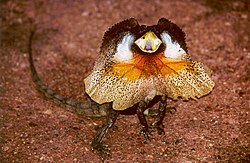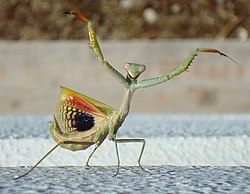Threat display
A threat display is anything that an animal does to scare away other animals. A dog will bare its teeth and growl. A cat will hiss. A snake will coil up, raise its head, and move back and forth to point itself at any big animal that approaches it.
Many animals have threat displays that make them look bigger. A lion's mane will stand up, making it look much larger and more powerful. Humans may raise both hands, spread wide, above their heads. Bears will stand on their hind legs, raise their front legs, and show their teeth while growling.
Some notable animals have no threat display, but do have a defence all the same. A male horse has a terrific kick backwards, no doubt developed as a defence against predators. People who ride horses have to be told not to walk close behind a male horse, even if they have ridden it before.
Threat Display Media
Spirama helicina resembling the face of a snake in a deimatic or bluffing display
Threat displays are not always deimatic bluff. Some stick insects spray the monoterpene chemical dolichodial when attacked, so their displays are honest aposematism.
A puss moth (Cerura vinula) caterpillar displaying its two flagella on its tail and red patches on its head. If the threat does not retreat, the caterpillar can fire formic acid from its flagella.
Deimatic display: Callistoctopus macropus generates a bright brownish red colour with white oval spots when disturbed.
Frill-necked lizard faces predators, making itself look big with head frills, raising its body and waving its tail.
Deimatic display of the phasmid Peruphasma schultei
Threat pose of the phasmid Haaniella dehaanii
An adult female Mediterranean mantis, Iris oratoria, in threat pose
Female eyed hawkmoth, Smerinthus ocellatus, mounted to show the large eyespots
Peacock butterfly, Aglais io, is a cryptic leaf mimic when its wings are closed.











